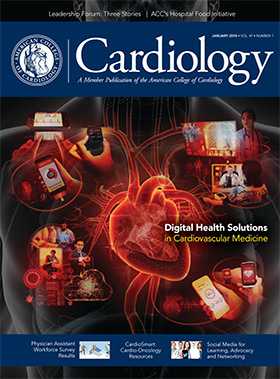Pulse of ACC | New Guidance to Optimize Heart Failure Treatment and More
New Guidance to Optimize Heart Failure Treatment and More.
ACC Roundtable Addresses Intersection of Antiplatelets, Anticoagulants
The ACC recently held its fifth Anticoagulation Consortium Roundtable focusing on the intersection of anticoagulation with antiplatelet therapy. In reaction to recent and anticipated large trial results on the topic, Roundtable participants examined the latest evidence and studies and discussed ways these results can and should inform future ACC initiatives, clinical documents and tools. Several recently created apps and tools were highlighted, including the DAPT Risk Calculator.
The Roundtable also provided a forum to address controversies and unmet needs in anticoagulation management in valvular atrial fibrillation (AFib) and chronic kidney disease. Mintu Turakhia, MD, MS, FACC, talked about the complex relationship between AFib and kidney disease, how each increases risk of the other, while both increase risk of ischemic stroke. “We have enough data to be worried, but not enough data to be sure,” said Turakhia. Additionally, the perception of risk, threshold for treatment, and disparities in care associated with gender and race were also explored. Stacie L. Daugherty, MD, MSPH, FACC, showed that race and ethnic minorities, as well as women, receive less oral anticoagulants (OAC) at all levels of risk. Daugherty concluded that interventions aimed at increasing appropriate OAC use, particularly for this population segment, are needed.
The discussions and multidisciplinary insights coming out of the Roundtable will be used to inform outputs and further develop resources.
ACC CEO to Head New Biopharmaceutical Company
 Cathy Gates, ACC's chief operating officer and executive vice president
Cathy Gates, ACC's chief operating officer and executive vice president
 Shalom “Shal” Jacobovitz, ACC’s chief executive officer
Shalom “Shal” Jacobovitz, ACC’s chief executive officer
ACC’s Chief Executive Officer, Shalom “Shal” Jacobovitz will be leaving the College effective Feb. 2, to lead CiVi Biopharma, Inc., a privately held biopharmaceutical company. Cathy Gates, ACC chief operating officer and executive vice president, will serve as interim CEO.
“There is no doubt that Shal is leaving a legacy that will continue to benefit the College well into the future,” says Mary Norine Walsh, MD, FACC, ACC president and chair of the Board of Trustees. “While he will be missed, his leadership over the last several years has ensured the ACC’s overall financial health, operational effectiveness and strategic direction are aligned to meet the needs of our members around the globe.”
Jacobovitz was hired in 2013 to leverage the organizational strengths of the College and to take advantage of opportunities associated with the changing health care environment. Since then, he has helped transform the College into a more nimble, strategic, innovative and accountable organization committed to transforming cardiovascular care and improving heart health. Specifically, he has built a culture of staff empowerment and played a key role in working with ACC leaders to transform the College’s governance structure and processes; foster a culture of innovation and continuous learning; and ensure alignment of programs and resources with the College’s strategic plan. Under his leadership the ACC has been recognized among the best places to work by Modern Healthcare.
“It has been a privilege to lead the ACC over the last nearly five years,” Jacobovitz says. “I’m proud of what the College has accomplished during this time and I have no doubt that the Board of Trustees, working with Cathy and the rest of the College’s dedicated staff, will continue to work toward actualizing the vision of a world where innovation and knowledge optimize cardiovascular care and outcomes.”
The ACC will undertake a nationwide search for its next CEO. In the meantime, the BOT has appointed Gates as interim CEO.
New Guidance Issued to Optimize Heart Failure Treatment
A new ACC expert consensus decision pathway aims to help streamline treatment of patients with heart failure and ensure the best possible patient outcomes by addressing 10 “pivotal” issues that remain unresolved in clinical guidelines.
“Heart failure care has become increasingly complex with multiple medications that are evidence-based, several choices of devices and an array of process of care interventions,” says Clyde W. Yancy, MD, MSc, MACC, chair of the writing committee. “Despite new guideline statements, information voids exist, and a practical, consensus approach is needed for areas that have incomplete evidence.” Read More >>>
The new document complements the 2017 ACC/AHA/HFSA Focused Update of the 2013 ACC/AHA Guideline for the Management of Heart Failure by addressing new medical therapies, prevention and comorbidities relevant to heart failure with reduced ejection fraction for which data are available. Specifically, the document focuses on the following 10 areas:
- How to initiate, add or switch therapy to new evidence-based guideline-directed treatments for heart failure with reduced ejection fraction
- How to achieve optimal therapy given multiple drugs for heart failure including augmented clinical assessment that may trigger additional changes in guideline-directed therapy (e.g., imaging data, biomarkers, and filling pressures)
- When to refer to a heart failure specialist
- How to address challenges of care coordination
- How to improve adherence
- What is needed in specific patient cohorts: African Americans, the frail, and older adults
- How to manage your patients’ cost of care for heart failure
- How to manage the increasing complexity of heart failure
- How to manage common comorbidities
- How to integrate palliative care and transition to hospice care
“These are the objectives that the everyday provider wants addressed,” Yancy says. “Achieving not just optimal therapy for HFrEF but an appropriate regimen for each patient given the prevailing clinical scenario is the goal.”
According to Yancy, the document contains numerous algorithms of care, informative tables and important call-outs to emphasize best practices for consideration. “This Pathway document, plus subsequent digital-friendly tools, will hopefully provide a more rapid uptake of best treatment strategies and in turn support best outcomes for patients with heart failure,” he says.
"This document is not a guideline statement but a straightforward response to 10 pivotal issues and is a major step toward deploying aspects of implementation science as a means of improving adherence to evidence-based guideline-directed therapy." — Clyde W. Yancy, MD, MSc, MACC
Each member of the writing committee – representative of all stakeholders – facilitated a separate survey with their own constituency to ensure the document addressed and acknowledged as many needs as possible. In addition, the document was among the first of its kind to be open to public comment during peer review. During revisions of the document, public comments were given the same weight as those from the formal peer-review process. Moving forward, the writing committee suggests this public-comments process may be a new way of developing documents, in the hope that it will allow consensus to follow much more quickly than before.
“There has been a challenge with implementation of guidelines across the board,” Yancy says. “This document is not a guideline statement but a straightforward response to 10 pivotal issues and is a major step toward deploying aspects of implementation science as a means of improving adherence to evidence-based guideline-directed therapy.”
Keywords: ACC Publications, Cardiology Magazine, Anticoagulants, Atrial Fibrillation, Trustees, Hospice Care, Consensus, African Americans, Leadership, Stroke Volume, Goals, Palliative Care, Heart Failure, Hospices, Cardiology, Minority Groups, Peer Review, Renal Insufficiency, Chronic, Comorbidity, Stroke, Writing, Biomarkers, Algorithms
< Back to Listings

